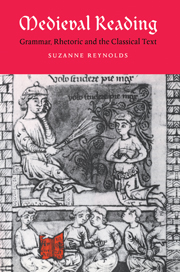Book contents
- Frontmatter
- Contents
- Acknowledgments
- Abbreviations
- 1 Introduction
- Part I CONTEXTS FOR READING
- Part II READING PRACTICE
- 4 Origins and mythologies: the invention of language and meaning
- 5 Reading word by word 1: the role of the vernacular
- 6 Reading word by word 2: grammatical and rhetorical approaches
- 7 From words to the phrase: the problem of syntax
- 8 Government: the theory and practice of a grammatical concept
- 9 Rival orders of syntax: vernacular, natural and artificial
- 10 From the phrase to the text: grammatical and rhetorical approaches again
- 11 Naked intention: satire and a new kind of literal reading
- 12 Literacy: a new model for the classical text in the Middle Ages?
- Notes
- Select bibliography
- General index
- Index of manuscripts
- Cambridge Studies in Medieval Literature
9 - Rival orders of syntax: vernacular, natural and artificial
from Part II - READING PRACTICE
Published online by Cambridge University Press: 22 September 2009
- Frontmatter
- Contents
- Acknowledgments
- Abbreviations
- 1 Introduction
- Part I CONTEXTS FOR READING
- Part II READING PRACTICE
- 4 Origins and mythologies: the invention of language and meaning
- 5 Reading word by word 1: the role of the vernacular
- 6 Reading word by word 2: grammatical and rhetorical approaches
- 7 From words to the phrase: the problem of syntax
- 8 Government: the theory and practice of a grammatical concept
- 9 Rival orders of syntax: vernacular, natural and artificial
- 10 From the phrase to the text: grammatical and rhetorical approaches again
- 11 Naked intention: satire and a new kind of literal reading
- 12 Literacy: a new model for the classical text in the Middle Ages?
- Notes
- Select bibliography
- General index
- Index of manuscripts
- Cambridge Studies in Medieval Literature
Summary
The Vulgaria mistranslations clearly demonstrate the pitfalls that classical Latin word order presented for students who adhered too rigidly to the syntactic patterns of their mother-tongue and who failed to take into account that in classical Latin, word order is principally to do with style rather than meaning. But, even though the freedom of its word order constituted one of the most difficult problems for medieval students of Latin, and even though Old French was moving away from its two-case system towards a syntax where word order was more significant, there is more at stake here than a clash of Latin and vernacular paradigms. Sequential syntactic glosses on classical texts, in certain respects the forerunners of the Vulgaria, impose onto the text orders that are not easily equated with particular vernacular languages. Indeed, in the same way that translation glosses do not really ‘vernacularise’ the text, but rather form part of a series of defining strategies developed within the art of grammatica, I shall argue that sequential glosses owe more to models of exposition sanctioned by grammatica than to any particular vernacular. There is then a further step to take, away from the vernacular and into the trivium. Given that syntactic glosses look at the phrase (oratio) rather than the word (dictio), the expository models in which they are founded impose a grammatically based structure onto a rhetorically motivated text.
- Type
- Chapter
- Information
- Medieval ReadingGrammar, Rhetoric and the Classical Text, pp. 110 - 120Publisher: Cambridge University PressPrint publication year: 1996



